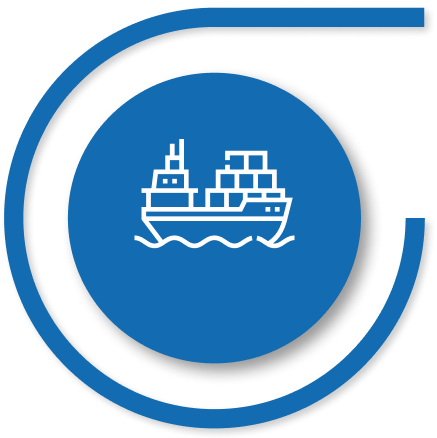
Did you know that 85% of supply chain delays are caused by mistakes in handling paperwork? This shows how big a problem paper-based communication is in logistics, leading to inefficiency and costly errors. That’s where Electronic Data Interchange (EDI) comes in. By using digital documents instead of paper, EDI has changed the way logistics work, making everything faster, more accurate, and smoother. With EDI, companies can share important information instantly, cutting down on mistakes and delays. The result? A more efficient, cost-effective logistics process that keeps up with today’s fast-paced world.
What is EDI in Logistics?
In logistics, every second counts, and every mistake costs. EDI transforms how businesses communicate and exchange critical information, enabling the swift, error-free transfer of documents like purchase orders, invoices, and shipment tracking. This eliminates delays and mistakes tied to paper-based processes, streamlines communication, and helps businesses manage inventory more effectively, reduce disruptions, and make quicker decisions. In today’s competitive landscape, EDI isn’t just an option—it’s a necessity for staying efficient, agile, and ahead of the game.
How Does EDI for Logistics Work?
Automating the Exchange – No more manual tasks! EDI automates the transfer of documents between businesses and logistics partners, ensuring seamless partner onboarding and faster operations.
Initiating EDI Transactions – Companies create electronic documents like purchase orders or shipment notices and securely send them to their partners, including carriers and suppliers.
Smooth Reception & Action – The recipient’s EDI system reads and converts the document into their format. Then, they take action—whether it’s updating inventory, scheduling shipments, or processing invoices.
Eliminating Human Error – EDI reduces the chances of mistakes, ensuring the data transferred is accurate, which leads to fewer delays.
Real-Time Updates – Businesses receive up-to-the-minute information about shipments, inventory levels, and more, making decisions faster and more informed.
Standardized Data for Better Collaboration – Using formats like X12 and EDIFACT, EDI ensures compatibility across different systems, making it easy for businesses with different software or processes to work together.
Boosting Efficiency Across the Supply Chain – With streamlined communication, reduced costs, and increased transparency, EDI enhances the overall efficiency of logistics operations.
Top Benefits of EDI for Logistics

Accurate Shipment Tracking
EDI makes sure shipment tracking is updated instantly. It automatically sends information about where a shipment is and its status, reducing mistakes. This lets everyone involved – like warehouses, shippers, and customers to see accurate, up-to-date tracking details. This helps improve customer service and lets companies make better decisions to fix delays or improve delivery routes.

Faster Freight Management
EDI improves the speed of the entire freight management process by automating routine tasks like booking shipments, confirming order statuses, and generating invoices. The immediate transmission of data between partners accelerates decision-making, reduces paperwork, and minimizes delays associated with manual processing. This makes deliveries quicker, improves inventory control, and boosts customer satisfaction.

Real-Time Communication with Carriers
EDI allows businesses and carriers to communicate directly and instantly. With EDI transactions like shipment updates (EDI 214) or routing instructions (EDI 753), logistics managers can quickly send and receive information, preventing miscommunication and making operations smoother. This quick communication helps adjust plans faster when things change, reducing delays and improving service reliability.

Streamlined Customs Documentation
With EDI, logistics companies can automate the submission of customs documentation. This eliminates the need for manually entering data, reduces the risk of errors, and speeds up the clearance process. Through standardized EDI formats, businesses can easily share information with customs authorities and regulatory bodies, ensuring compliance and reducing the likelihood of delays at border crossings.

Optimized Route Planning
EDI helps optimize route planning by giving businesses real-time data on traffic, delays, and other factors that affect delivery times. With this information, companies can quickly adjust their plans to save on fuel, improve delivery speed, and make better use of resources. EDI systems also automate the creation of the best route plans, making everything more efficient.
Common EDI Transactions for Logistics

EDI 204: Motor Carrier Load Tender
This transaction is used to electronically transmit a load tender from the shipper to the motor carrier (truck company). It outlines the specifics of the load, like where it is going, when it needs to be picked up, and other key information. It allows carriers to quickly review the load and respond with an acceptance or rejection.

EDI 210: Motor Carrier Freight Details and Invoice
The EDI 210 is a transaction used to submit freight details and invoices. It has details like the cost of transportation, any additional fees, and other charges related to the shipment and allows carriers to send billing information to shippers and receivers, ensuring prompt and accurate payment processing.

EDI 214: Transportation Carrier Shipment Status Message
This transaction provides real-time updates on the status of a shipment. It communicates key information, such as delivery status, delays, or potential issues, directly from the carrier to the shipper, improving visibility and decision-making.

EDI 753: Request for Routing Instructions
EDI 753 is used when a shipper requests specific routing instructions from a carrier or third-party logistics provider. It includes information on the preferred route, delivery time frame, and other essential details.

EDI 754: Routing Instructions
This transaction is used to provide detailed routing information for shipments. It tells the carrier how to transport the goods, including specific routes, stops, and any special handling requirements. This transaction helps ensure that the shipment follows the correct path and that everyone involved in the transportation process is on the same page regarding the delivery instructions.

EDI 846: Inventory Inquiry/Advice
EDI 846 is used to share inventory information between businesses. It allows one party (like a supplier or distributor) to request or provide details about inventory levels, such as available stock, quantities on hand, or items that need to be reordered. This transaction helps businesses keep track of inventory and manage their stock more efficiently.

EDI 850: Purchase Order
The EDI 850 is a standard transaction for placing an order with a supplier. It includes details like the items being ordered, quantities, prices, delivery dates, and other relevant terms. This transaction streamlines the purchasing process by automatically sending order information, reducing paperwork and minimizing errors.

EDI 855: Purchase Order Acknowledgement
EDI 855 is used by a supplier to confirm or acknowledge a buyer’s purchase order (EDI 850). It lets the buyer know that the supplier has received the order and either accepts it as is, accepts it with changes, or rejects it. This helps both parties stay aligned on the details of the order and ensures clear communication.

EDI 856: Advance Shipment Notice
The EDI 856 is an electronic notification sent by a supplier or shipper to inform a buyer or receiver about a shipment that’s about to be delivered. It includes details like the contents of the shipment, tracking information, expected delivery date, and any other relevant details. This helps the receiving party prepare for the arrival of goods and streamlines the receiving process.

EDI 990: Response to a Load Tender
This transaction is used by a carrier to respond to a load tender sent via EDI 204. It lets the shipper know whether the carrier accepts, rejects, or counters the proposed shipment details. This helps both parties quickly communicate and finalize shipment arrangements.

EDI 997: Functional Acknowledgement
The EDI 997 is used to acknowledge the receipt of an EDI message. It doesn’t contain the details of the original message, but it lets the sender know that their document was received and is being processed. If there’s an issue with the message (like incorrect formatting), the 997 can include an error notification. It’s mainly used for ensuring that all EDI communications are properly received and understood.
How iTech’s EDI Service Enhances Logistics Management
At iTech, we understand that managing logistics effectively is critical to your business success. That’s why our EDI service integrates seamlessly with your current systems, automating data exchanges and making logistics operations faster, more accurate, and more efficient. Here’s how our clients are benefiting from iTech’s EDI services after implementation:

Eliminating Errors and Speeding Up Processes
After implementing our EDI solution, one of our clients, a global supplier, reported a 50% reduction in order processing time. By automating purchase orders and invoices eliminated manual errors, speeding up order fulfillment and invoicing, leading to better customer satisfaction and fewer payment disputes.

Real-Time Tracking and Proactive Issue Resolution
One of our retail client gained full visibility of shipments in real-time, allowing them to track goods across multiple locations. When delays occurred during peak season, they identified and resolved the issue quickly, resulting in an 80% reduction in customer complaints.

Optimized Decision-Making and Cost Reduction
A logistics provider used iTech’s EDI services to access real-time data on inventory, deliveries, and shipments. With this insight, they optimized routes, cutting fuel costs and reducing transit times, allowing smarter decisions and better operational efficiency.

Scalability to Meet Growing Demands
A fast-growing e-commerce company used iTech’s EDI platform to seamlessly integrate new suppliers and carriers across regions. This reduced integration time by 40%, allowing them to scale efficiently and manage higher order volumes.
Overall, EDI makes logistics operations more efficient, accurate, and responsive, helping businesses stay ahead in an increasingly fast-paced environment.
Looking to improve your logistics operations? Reach out to us today and find out how iTech’s EDI services can take your business to the next level.









